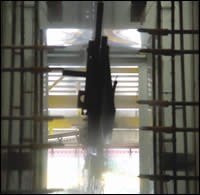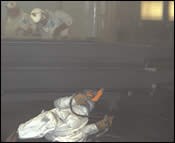Not Your Average Recreational Powder Coating Facility
Lippert Components converted the paint line at one of its facilities to a manual powder coating line. At another facility it converted to an automated system. The success of these two plants is now being felt at all of its facilities...
Northeastern Indiana, Elkhart County, is the RV capital of the world. So, what more perfect place could there be to manufacture and powder coat chassis and parts for the RV market? And this includes not only parts for the RV market, but related items such as trailers for boats and personal water craft. Lippert Components, Inc., a Drew Industries subsidiary, headquartered in Goshen, Indiana, actually has 41 facilities across the United States and is a leading supplier to nearly all the leading producers of RVs and manufactured homes.
The conversion to powder coating from traditional liquid coating was driven by customers. Cliff Boyer, powder coating manager, spearheaded the project. Boyer knew the conversion would enable the company to achieve a better finish more cost efficiently. His powder coating system designs and knowledge of the parts helped Lippert and its suppliers develop a highly productive and efficient system with the capability to powder coat and cure a four-chassis load in 20 minutes.
RV chassis and trailers are built onsite at the Middlebury plant and hoisted to the powder coating line where they are hand-wiped with an alkaline cleaner solvent. The chassis and/or parts are then routed into the blast cleaning room.
Workers use ABS blast rooms equipment to blast the parts with 46 grit alumina oxide blend at 95 psi. At this pressure and grit size, all mill scale, oils, metal working fluids and lubricants are successfully removed. Aluminum oxide grit is quicker at removing mill scale, according to Boyer. The alkaline cleaner brings the oils, lubricants and fluids to the surface so they can be removed by blasting. That way, fish eyes will not develop in the final finish.
"The abrasive nature of the grit, can really tear up the system," comments Boyer. "The hoses have thick rubber IDs and the augers in the bottom of the chamber are programmed to move slowly to keep the blast media from ‘eating up' the equipment." The media is recycled eight times before it is sold back to the supplier.
Following cleaning, parts move linearly to the powder coating booth where a team of six to eight powder spray gun operators manually coats the parts using ITW Gema spray guns. An automatic system would not work in this situation because of the size and complexity of the parts. Also, there are issues with Faraday Cage because of all the right angles involved in the chassis systems. Even so, 90% transfer efficiency (TE) is achieved in this spray-to-waste setup. Boyer explained that a key reason for the exceptional TE is that all parts are double grounded upon entering the booth. This ensures that powder attracts directly to the parts.
Lippert Components worked closely with Environmental Coatings, Inc. when developing the powders for both its manual and automated lines. The coating used on the manual line is an exterior grade powder that exceeds Lippert's specifications for UV stability and salt spray. During development, particle size was carefully considered since it affects TE. Also, Lippert wanted to be sure that the powder would adhere to the sharp edges of its parts and not "pull away" during the cure cycle.
Parts traverse linearly from the powder coating booth to the ovens. The oven is maintained at 450°F, even though parts cure at 350°F. The oven uses recirculating air at 20,000 cfm to achieve the necessary air turns in the oven. Twice a year, Environmental Coatings, Inc. runs an oven profiling system through the powder coating line to profile cure temperatures. Probes are attached to various areas of a part to record temperatures, ensuring that the entire part cures properly. The information from the system provides data on how hot the product became for how long, what temperature it reached and at what point.
An automated powder coating system has been installed at Lippert's Milford plant for finishing boat trailers and snowmobile towing equipment as well as dump beds for trucks. At this location, parts are assembled after coating unlike the Middlebury plant, where the chassis are preassembled.
At the Milford plant, cleaning is accomplished with a two-stage spray system with vertical riser, which apply the solution. Stage one is a spray cleaner/phosphate bath, followed by a phosphate, followed by a rinse using reverse osmosis (RO) water. RO water is used throughout the system for bath makeup and to replenish for evaporation losses. Stage one evaporates at 1- 1 ½ gpm and stage two feeds into stage one. A filtration system helps to maintain the consistency of the cleaners. Lippert also has the capability to introduce a sealer at the end of the cleaning line if they find it necessary. Following cleaning, parts run through a 400°F dry-off oven before entering the powder coating booth.
The Diamond Series powder coating booth features an ITW Gema AutoTracker™ control system. This system features a light curtain at its entrance, providing incoming part recognition data to the Programmable Logic Controller (PLC), automatically adjusts optional analog powder delivery controls to optimize gun current, voltage, air mix, flow rate and other settings for each part. The system also monitors powder and booth functions to identify motor overloads, filter status, compressed air quality and powder reclamation and reprocessing factors.
ITW Gema's OptiSystem™ spray guns are used in the automated powder coating booth. The guns use an integrated cascade power supply for maximum charging at the tip of the gun. Also, the gun body is sealed to prevent powder from entering the internal cavity, eliminating potential voltage and color-change contamination problems.
Quick color change capabilities were a key factor in choosing this 20,000 cfm automated powder coating system. "We can change colors in about 10 minutes," stated Boyer. "The guns basically purge themselves with the push of a button. This leaves the operators plenty of time to change out the hopper." The Chameleon™ Color Management System from ITW Gema controls internal cleaning of suction tubes, pumps, powder hoses and spray guns.
"We are also concerned about transfer efficiency," comments Boyer. "These parts, as do the parts at the Middlebury plant, have a number of right angles, which make Faraday cage an issue. These automatic spray guns run at lower pressures that provides a softer spray pattern that helps improve transfer efficiency. Even so, we never stop working to improve transfer efficiency. We continue to work on better grounding and increasing line density."
Apparently, lighter powder coating colors pose more of a coverage challenge than the darker colors. "It has a lot to do with grounding," Boyer again notes. "We are working with the suppliers to overcome this by getting greater mil build. We don't use as many light colors though. Black is the predominant color. We use more than a million pounds of gloss black powder each year." Still, Lippert offers its customers more than 15 powder coating colors.
One stipulation Lippert had for the powder was that it have as smooth a finish as possible without jeopardizing edge coverage. Also, the powder had to meet or exceed the company's salt spray and UV specifications. The powder withstands 2,500 hrs QUV with less than a 10% gloss loss and 2,000 hrs salt spray. Working with particle size and other factors, a super-durable TGIC powder was developed that provides excellent coverage at a low cure while meeting
specifications.
The booth's cartridge collector assembly uses horizontally mounted filters from outside the unit and side-draft modules that are interchangeable for quick color changes. The collector opening is at floor level for easy removal of the powder and transfer to the reclaim assembly. Lippert reclaims all the powder in one assembly. The reclaimed powder is mixed with some virgin powder and used to powder coat parts for customers that are not particularly concerned about color but simply want the high quality powder coated finish.
After coating, parts travel through a two-stage recirculating convection oven. The first several feet of the oven are baffled to contain the velocity of the hot air. Often, the two-stage oven is operated to save energy. Burners can be regulated to adjust temperature needs (depending on part size, thickness, etc.). A forced cooled-down follows. Parts are then unloaded and stored or shipped.
Lippert Components' success with both of these powder coating installations is the inspiration for converting additional facilities in the United States from liquid coating to powder coating. "It has been a lot of work to convert these facilities," notes Boyer. "But it is definitely worth it for both Lippert and our customers. The customer gets a smooth, strong, durable finish; while the company has been able to improve production with quick color changes, higher transfer efficiency and increased line density, which helps with the bottom line."
Read Next
Delivering Increased Benefits to Greenhouse Films
Baystar's Borstar technology is helping customers deliver better, more reliable production methods to greenhouse agriculture.
Read MoreA ‘Clean’ Agenda Offers Unique Presentations in Chicago
The 2024 Parts Cleaning Conference, co-located with the International Manufacturing Technology Show, includes presentations by several speakers who are new to the conference and topics that have not been covered in past editions of this event.
Read MoreEducation Bringing Cleaning to Machining
Debuting new speakers and cleaning technology content during this half-day workshop co-located with IMTS 2024.
Read More













.jpg;maxWidth=300;quality=90)







